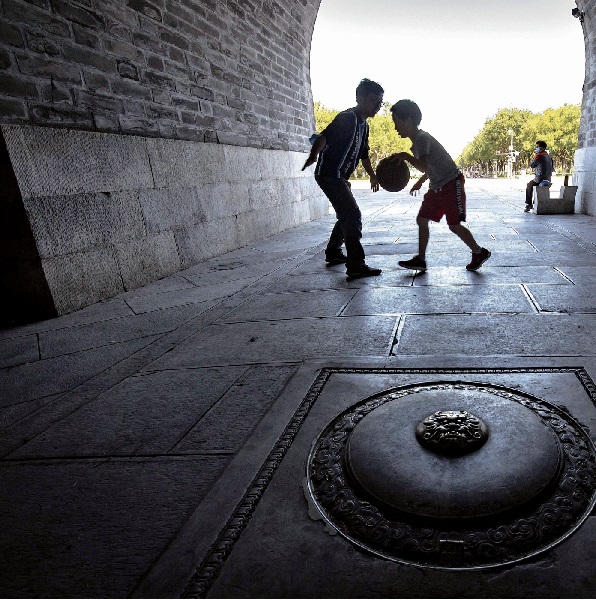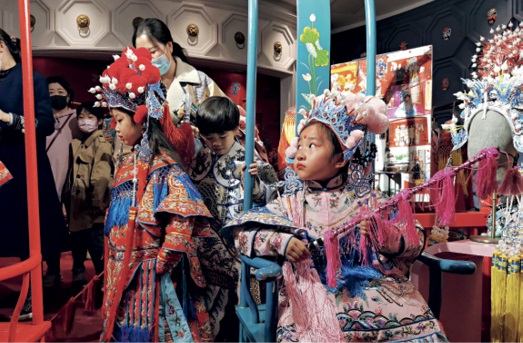The Central Axis of Beijing is special in light of the important symbolic connotation of the capital’s planning principle.

A father and his son are playing basketball at the south end of the Central Axis under the Yongding Gate in Beijing, on September 19, 2020.
Cultural heritage is the legacy bequeathed to us by the past that we honor today and pass on to future generations. The primary mission of the World Heritage Convention, which UNESCO adopted in 1972, is to identify, protect, and preserve the natural and cultural heritage of each nation, and of humankind as a whole, that is considered to be of outstanding universal value.
Inscription on the UNESCO World Heritage List is of vital importance to protecting and preserving cultural heritage sites. UNESCO consequently receives nomination proposals from many countries every year.
A successful nomination depends on two main factors, namely, a clear identification of the heritage value of the nominated property, and a suitable framework of management and protection after it is listed. Problems that sometimes arise include either inadequate or overly generic identifications of the property concerned, and an incapacity to cope with the pressures and hazards that inevitably accompany each nomination proposal. The main problems, however, usually relate to unsustainable types of tourism, and the resultant economic pressure on both heritage sites and local populations that risk prejudicing the authenticity or even native topographical characteristics of a site.

Children are learning about Peking Opera costumes at the 200-year-old Tianleyuan Theater located at the east end of Xianyukou Street – a time-honored business block at Qianmen Street in Beijing.
China is applying for the World Cultural Heritage status of the Central Axis of Beijing, which is the site of a series of buildings stretching along a total distance of 7.8 km, from north to south, in the heart of the Chinese capital. These include monuments, former imperial buildings, temples, and other historical sites, notably the Forbidden City and the Temple of Heaven.
The history of the urban axis principle goes back to antiquity. It is apparent everywhere – in, for example, Palmyra, a prosperous oasis city in Syria in the 3rd century A.D. with unique aesthetic achievements. But the axis became an ubiquitous aspect of urban planning from the Renaissance onwards, having first appeared in Baroque Rome in the 16th and 17th centuries, through to George-Eugène Haussman’s redesign and rebuilding of Paris in the 19th century. Such major modern capitals as Washington D.C. and New Delhi also feature major axes.
The Central Axis of Beijing, however, is somehow special in light of the important symbolic connotation of the capital’s planning principle. In spite of the presence of historical monuments along the Central Axis of Beijing, most notably that of the Forbidden City, the significance of the physical axis and its continuity is not compromised. It is an Asian axis which no city other than Beijing can exemplify.
The “historic urban landscape” concept – an approach to the management of cultural heritage resources within dynamic and constantly changing environments – plays a vital role in urban planning and in protecting historic urban landscapes. The application for inscription on the World Heritage List of the Central Axis of Beijing complies with the Recommendation on the Historic Urban Landscape that UNESCO adopted in 2011. The aim of this project is to incorporate policies and practices relating to conservation of the built environment with the wider goals of urban development with respect to the inherited values and traditions of different cultural contexts.
Urban cultural heritage is a witness to urban history. As, in today’s world, building modern cities is the common goal of urban development, our societies are compelled to reconcile the protection of historical and cultural heritage with urban modernization. More than ever, cities must value urban heritage in a way that goes beyond monuments to their very urban fabric, however subtle it may be, in order to preserve traces of the past for future generations.
Today, both cultural and natural heritage is under the ever growing threat of destruction, as the result of degradation or of changing social and economic factors. But the digital age brings new approaches to protecting and enhancing our cultural and natural heritage. Having created so many opportunities in this regard to expand international recognition of our heritage, UNESCO sites are now just a click away. There is hence enormous potential for educating the general public, as well as school children, not to mention the contributions that technology can make to site management through the monitoring of buildings and visitors. Such possibilities demand further exploration. 
FRANCESCO BANDARIN is an Italian architect, former director of the UNESCO World Heritage Center and former assistant director-general of UNESCO for Culture.